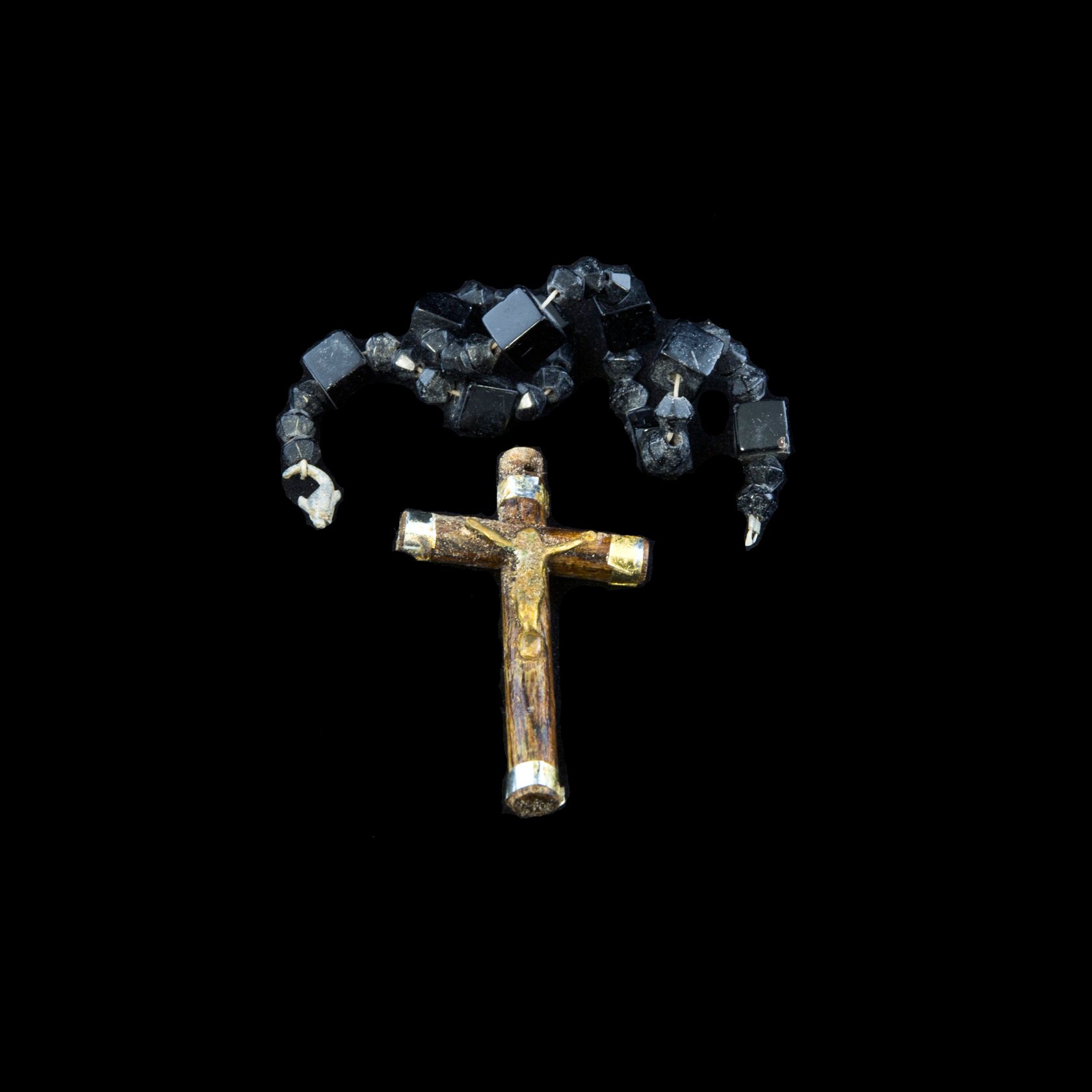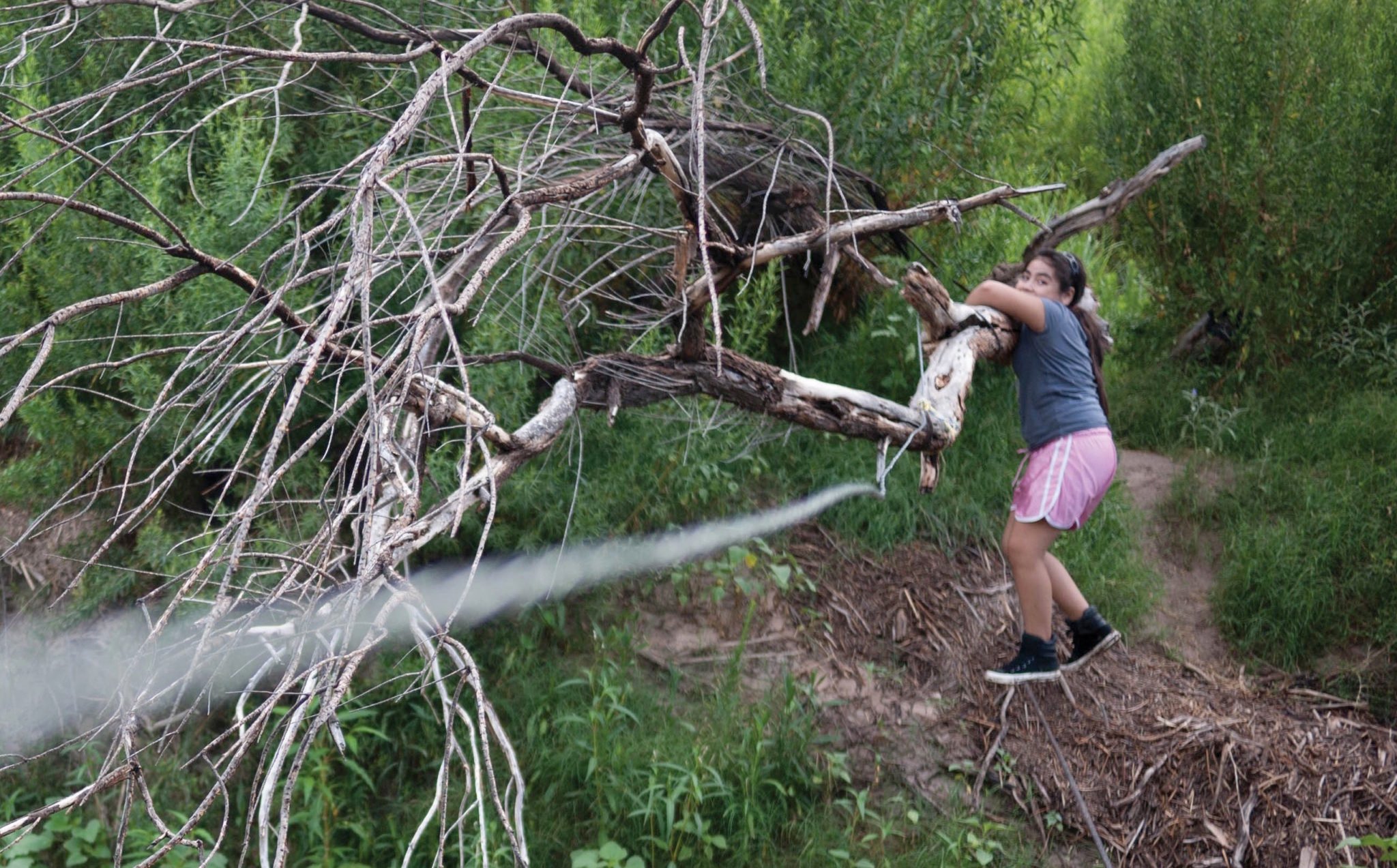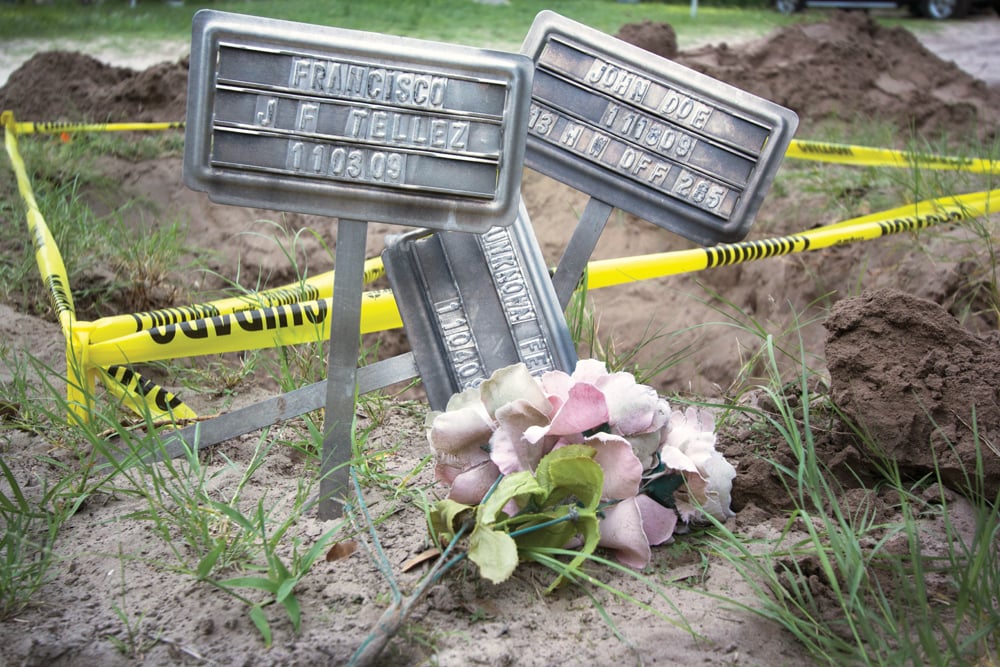
Graves of Shame
New evidence indicates wrongdoing in the handling of migrant remains in Brooks County.
A version of this story ran in the July 2015 issue.
In the summer of 2013, a team of forensic anthropologists from Baylor University and the University of Indianapolis descended upon Sacred Heart Cemetery, a small, county-run graveyard in rural Brooks County. Small metal markers with the words “Unknown” or “Skeletal Remains” were scattered through the dusty grass and along the cemetery access roads. More than 300 migrants had died in the county during the past five years, and unidentified human remains ended up here. For Dr. Lori Baker, a forensic anthropologist at Baylor University, identifying migrant remains and returning them to grieving families had become a mission. “Nobody cares about dead immigrants,” she said recently. “They’re invisible when they’re alive, and they’re even more invisible when they’re dead.” For years, she and her students had been conducting exhumations and gathering DNA samples across the border regions of South Texas. But she’d never gone as far inland as Falfurrias, home to a Border Patrol checkpoint some 70 miles north of the Texas-Mexico border. As she had elsewhere, she approached the chief deputy sheriff, Benny Martinez, to offer her services. “Of course the chief was like, ‘Yes, we could use all the help we can get, any help you can give us,’” Baker said.
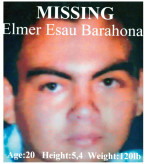
She knew the graves might be difficult to locate. “I can tell you that we have yet to find a cemetery that has a map,” she said. “So you can’t look at a map and know where human remains are buried. Especially when they’re not marked.” Still, even she was surprised by what she found at the cemetery. Digging around a handful of markers, Baker and her team of volunteers expected to find maybe 10 bodies. Instead, they exhumed more than 50 unidentified human remains during the course of 10 days, all presumed to be border crossers from Central America and Mexico. Some were buried in coffins; others in only body bags. She planned to go back the following summer to continue. When Baker returned in early June of 2014, she came with a larger team in order to cover more ground. They recovered nearly 70 more human remains. This time, what they found made the evening news. “Mass Graves of Unidentified Migrants Found in South Texas,” read a headline in the Los Angeles Times. Reports emerged of bodies buried in kitchen trash bags, with as many as five piled on top of one another in a single grave. One corpse was wrapped in a burlap bag; other remains were found inside a milk crate. Skulls were wedged between coffins, Baker said. The shocking news attracted the attention of elected officials. By month’s end, state Sen. Juan “Chuy” Hinojosa of McAllen, 75 miles to the south, said he would ask the Texas Rangers to investigate. “This is too serious of a wrongdoing,” Hinojosa said. “I’m appalled at the number of bodies just left in body bags and, in many instances, more than one body in one bag.” On June 25, 2014, the Texas Rangers launched a preliminary inquiry to determine whether any criminal wrongdoing had occurred in the processing and burial of the unidentified remains. They assigned the job to Lt. Corey Lain, an experienced investigator who had recently been honored by the U.S. attorney in Dallas for his exemplary work on a federal attempted murder case. He was assigned to look into any improprieties on the parts of Elizondo Mortuary, which was tasked with collecting DNA samples, identifying bodies, and storing the remains before burial; Funeraria Del Angel Howard-Williams (Howard-Williams Funeral Services), which buried the remains and was suspected of improper burials, failure to properly mark remains and gravesites, and overbilling; and Brooks County, which was missing autopsy records. If Lain found evidence of possible lawbreaking, a criminal investigation would ensue. Three years ago, Elmer Barahona Iraheta, a 22-year-old father living in San Vicente, El Salvador, made a fateful decision. He had been struggling to find enough work in the impoverished agricultural city to support his wife and 2-year-old daughter, and gang violence there was spiraling out of control. But he had a contact in Houston who would help him find work. He pooled scarce resources to hire the services of a coyote, a human smuggler, to help him navigate the dangerous journey to the United States. It was the only way he could imagine providing a future for his new family.
“This is too serious of a wrongdoing,” Hinojosa said. “I’m appalled at the number of bodies just left in body bags and, in many instances, more than one body in one bag.”
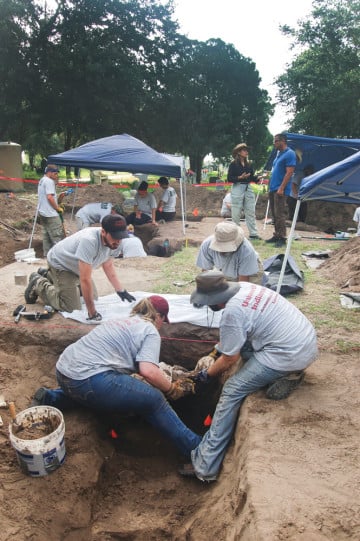
Texas law only lightly governs burials and the handling of human remains; in some cases, laws weren’t violated because the laws simply don’t exist. Lain notes, for example, “There are no statutes prohibiting more than one set of human remains to be buried with another at a government owned cemetery.” None of the forensic or funeral service experts I spoke with could dispute that claim. But a careful review of the practices Lain was charged with examining reveals that many laws and standard practices were violated in the handling of the unidentified remains. And these violations have made it nearly impossible for grieving families to locate and claim their loved ones. Repeated public-document requests of Brooks County produced only a fraction of what should be retained by law. According to the Brooks County Sheriff’s Office, from 2009 through 2013, the years when the mass graves were most active, 361 migrant remains were recovered in Brooks County. Each of those remains would have passed through multiple hands. When remains are discovered, a deputy sheriff is called to investigate the scene, along with a county justice of the peace who makes a determination of death. Funeraria del Angel Howard-Williams, the funeral home in nearby Hebbronville owned by Service Corporation International, the nation’s largest death services provider, then arrives to recover the remains, which are transferred to Elizondo Mortuary in Mission for processing. However, Texas law does not require processing and identification of human remains be performed by a licensed medial examiner. Elizondo is supposed to try to identify each set of remains, a process that by law includes gathering fingerprints, photographing any clothing or possessions, and “proper removal of a sample from a body” for lab tests. When Ramirez or a justice of the peace requests an autopsy, it is conducted by a third party—starting in 2007, that third party was a local pathologist, Dr. Fulgencio Salinas. After some weeks, Elizondo returns any unidentified remains to Howard-Williams for burial in Sacred Heart. At every stage, a paper trail accumulates. According to Texas law, death records must be retained for at least 10 years. The sheriff’s office turned over all 361 crime scene reports. But the Brooks County clerk’s office could locate files related to the retrieval and burial of no more than 121 of these remains, leaving records on two-thirds of the dead unaccounted for. According to notes from a series of meetings that took place from December 2012 to June 2013 between the forensic anthropologists and county officials, and confirmed by Chief Deputy Martinez, the county sheriff’s office never received from Salinas a single autopsy report during this period, despite repeated requests. By law, such reports must be made available to law enforcement. Also, despite requests, the sheriff’s office was never notified about which human remains had been positively identified and returned to loved ones. According to the meeting notes from Dec. 3-4, 2012, “no such list exists.” Lain was tasked with looking into missing autopsy reports, but, based on a conversation with the county auditor, determined that they’d been sent to the county along with the invoices. Yet in response to a request under the Texas Public Information Act, of the 72 autopsies ordered on unidentified remains from 2007 to 2013, the county clerk could not produce 14 of them—nearly one in five. The autopsy reports themselves are scattershot at best. Many are so incomplete and error-ridden, according to Baker, that if any of her students had handed one in as an assignment she would have given a failing grade. Many contain vague notes such as “teeth missing” and “cavities present,” without specifying which teeth. Salinas, the pathologist, typically inventories the bones, but does not include measurements or photographs, which Baker said is standard forensic procedure. Salinas describes a pelvis, a cheekbone, even a jaw as having the “characteristics of a male,” though the bones could easily have belonged to a woman. “If you get the sex of the person wrong,” Baker said, “you’ll never be able to make a positive identification.” It’s unclear how Salinas, a family doctor with a private practice in Edinburg, was charged with taking over the autopsies. His medical license indicates that he is not board-certified in pathology. Before 2007, the Nueces County coroner in Corpus Christi, a state-accredited medical examiner, had been contracted to handle identification and autopsies of unidentified remains found in Brooks County. But in 2007, just after Raul Ramirez was elected county judge, that work was steered to Elizondo Mortuary, a small family business, which took on the task of identifying remains and contracted out the autopsies to Salinas. The Brooks County clerk easily located the contract with Nueces County, which is still active, but could not locate one with Elizondo. In response to follow-up queries, a county auditor wrote, “There are no service contracts between Brooks County and Funeraria del Angel Howard-Williams Funeral Home or between Brooks County and Elizondo Mortuary.” I spoke with Ramirez, who said a courthouse renovation left a lot of records in boxes, adding, “It’s got to be there.” He said the main reason for moving the work to Elizondo Mortuary was cost—the Nueces County coroner, he said, was too expensive—and he claimed that Nueces County was too busy to manage the spiking migrant death toll in Brooks County. But the medical examiner for Nueces County at the time, Dr. Ray Fernandez, said Nueces County was fully staffed and prepared to receive bodies at any time. “I don’t know why the migrant bodies stopped coming here,” he said. And records indicate that costs may have actually risen since the work was moved to Elizondo. The Nueces County medical examiner billed for autopsies according to the complexity of the job. A complete autopsy from Nueces County was $1,500 to $1,800, while the forensic examination of a skull was $750 and a visual examination of bones could be billed for as little as $150. Meanwhile Salinas charged $1,500 for every autopsy documented in the invoices we obtained, including examination of bones. Salinas has been reprimanded by the Texas Medical Board several times for overbilling and shoddy record-keeping. In February 2007, Salinas was fined $500 for overbilling for copies of autopsy reports, charging $175 for a five-page report when board guidelines cap the cost at $25 for up to 20 pages. Seven months later, Salinas again charged $175 for a six-page autopsy report, plus a $25 search fee and a $35 processing fee. This time the board levied a $2,000 fine and required Salinas to provide a sample of his billing records to the board every month for a period of two years. In November 2011, the board reprimanded Salinas for failing to retain an autopsy report or provide it to family members. The board fined him $5,000, appointed a physician monitor to oversee his practice, and ordered him to complete coursework that included record-keeping ethics. Ramirez told me that he had met with Salinas personally and could vouch for his expertise as a pathologist and a medical examiner, despite his lack of certification. (Texas law does not appear to bar noncertified pathologists from performing autopsies.) There is no record that Lain had any communications with Salinas. The Texas Rangers declined to make Lain available for an interview, and Salinas did not return repeated calls. By September 2012, Marta Iraheta was in search of her nephew Elmer’s remains. She knew Elmer had been left behind in Brooks County and suspected that he had died there. By now, she had gathered information about what Elmer had been wearing: jeans; a gray T-shirt with an embroidered “Jaco Jeans” logo; over the T-shirt, a short-sleeved, brown-plaid shirt; and black Fila tennis shoes with red soles. At the sheriff’s office in Brooks County, Marta was invited to leaf through a thick three-ring binder containing photos and reports on every body recovered in the county that year, the remains of some 70 migrants.
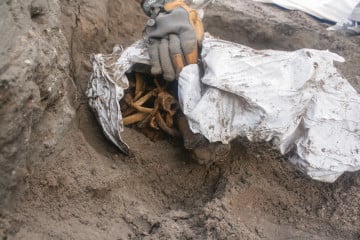
Marta began to look through the most recent photographs. She flipped past gruesome images of half-eaten corpses along with photos of sun-bleached skulls and skeletal remains. Then she turned a page and knew immediately that she had found Elmer. Half of his skull was visible where insects had eaten away parts of his skin. But there were the black shoes with red soles, and the shirt with the words “Jaco Jeans.” It was him. The police report said that his body was recovered on Palo Blanco Ranch on County Road 225. Cause of death: unexplained. Marta was horrified by the images of her young nephew, but after her long search she felt real relief to have found him. She asked how she could retrieve his body and send it back to his mother, his wife and his daughter. The sheriff’s office sent her to Elizondo Mortuary, and that afternoon, armed with copies of the police report and personal identification to prove that she was kin, she drove the 80 miles south to Mission. Elmer had been found. When she arrived, the mortuary was able to locate a file on remains they had received that contained the same photographs of Elmer’s clothing. But she learned that they’d been unable to identify his remains—so Elmer had been buried anonymously at Sacred Heart. One focus of Lain’s inquiry was to determine whether any of the burials of unidentified remains had violated Texas law. But his inquiry was cursory. His report indicates that he met with representatives of Howard-Williams at the cemetery to visit three sites where unidentified remains had been buried, and reviewed a single inquest provided by the funeral home. He noted Howard-Williams’ claim that, far from overcharging, “they were actually losing money in the removal, transport and interment of unidentified bodies,” and had contacted Brooks County officials regarding “their concerns about the limited space available … to bury unidentified human remains,” an assertion confirmed by Ramirez. Lain attributed any commingling of remains to “environmental elements [that] scatter human remains over a wide area,” and noted that decomposition also presented “a challenge.” “It is reasonable,” he concluded, that someone “could mistakenly remove two sets of partial human remains believing they are one.” And he notes that Texas law defines a casket simply as “a container used to hold the remains of a deceased person,” and that “there are no Texas statutes that govern the burial proximity, or positioning limitations, in relation to other buried human remains.” The Investigative Fund at the Nation Institute commissioned Baker’s team at Baylor University to do a thorough analysis of the 118 sets of human remains they have so far exhumed from Sacred Heart (the University of Indianapolis handled at least 30 other bodies), and they found potentially widespread violations of the law that would make identification almost impossible. Though Lain didn’t note this, Texas Health and Safety Code Title 8 requires human remains buried in a county cemetery to be placed in an impermeable container and buried at least 18 inches underground; remains in permeable containers must be at least 2 feet deep. The analysis shows that 51 of the 118 sets of human remains were not buried in coffins. Fourteen of the remains were placed in red biohazard bags; four in what appeared to be grocery store trash bags. Five were covered only in plastic wrap and packing tape. One set of remains was buried in a milk crate, while another was simply wrapped in clothing. It is unlikely that any of these constitute “impermeable” containers. Yet Lain’s report claims that “No evidence exists to show that the funeral home or the mortuary company used improper containers to transport or bury human remains.” Thirteen of the remains were found above the 2-foot mark, according to our analysis; five of these were shallower than 18 inches. Two were buried in black trash bags, less than 12 inches deep. Another set of remains was buried shallower than 2 feet and wrapped just in cloth. Yet another set of remains was found 22 inches below the surface in a plastic milk crate wrapped in a biohazard bag. (No records exist indicating that Lain sought out burial-depth information; indeed, there is no record of any communication between Lain and members of the exhumation team.) Though Lain was tasked with examining whether remains were improperly marked, his report never addresses this issue. “There were many more burials than there were grave markers,” Baker had previously told county officials, according to meeting minutes. “Many graves did not have markers, some graves had multiple markers but only one individual and many graves had one marker and multiple individuals in the grave.” Baker’s exhumation process was hampered by the lack of a plot record; Ramirez confirmed that none exists—a clear violation of Texas Health and Safety Code Section 711.003, which requires a record of each interment be kept, including “the identity of the plot in which the remains are interred.”
Forty-five of the 118 sets of human remains had no identification tags at all, making it next to impossible to correlate individual remains with a particular police report or death certificate.
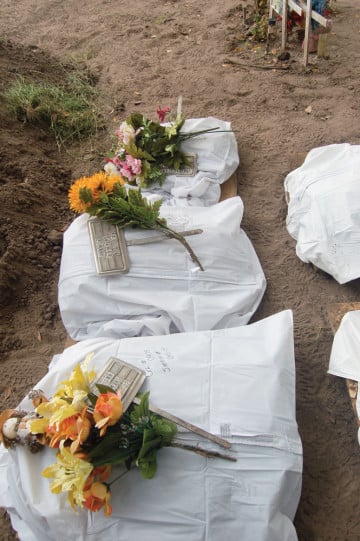
SCI’s CEO, Robert Waltrip, considers former Gov. Rick Perry a personal friend, and ranked as one of Perry’s top political donors during Perry’s tenure as governor, personally donating a total of $310,000 from 2001 to 2010, according to Texans for Public Justice. SCI also has a close tie to the Texas Rangers—its director of security, Robert K. Madeira, is a former Ranger lieutenant. Lain’s report relies in part on a June 26 memo from TFSC’s administrator for compliance, Rodney van Oudekerke. Lain notes that Howard-Williams cooperated fully with the TFSC inspection. Yet van Oudekerke’s three-page memo, obtained through an open-records request, indicates that his inspection amounted to a single meeting with SCI attorney Sheri Sarfoh. Van Oudekerke told me that he did not visit the cemetery or speak with the forensic pathologists who had exhumed remains. According to van Oudekerke’s memo, Sarfoh claimed that any commingled remains were the fault of the deputy sheriffs (though collecting the bodies is not in their purview), that any known information was included in the caskets, and that if there were missing grave markers, it was because the markers were temporary in nature. “It is my professional opinion,” van Oudekerke concluded, “the funeral home did not violate any rules or laws enforced by the TFSC.” Lain deferred to van Oudekerke, who told me, “Everyone was doing the best they could.” SCI has been mired in controversy for decades. In 2001, The Miami Herald reported that SCI had exhumed bodies to make room for fresh burials in an overcrowded cemetery in Palm Beach. The case resulted in a $14 million settlement with Florida’s attorney general. In 2009, The Washington Post reported that another SCI funeral home, in Falls Church, Virginia, failed to properly store the bodies of veterans. The decomposing bodies were described as “disgusting, degrading and humiliating.” (SCI defended the practice, saying Virginia has no law that requires bodies to be refrigerated.) According to a 2013 story in Bloomberg Businessweek, SCI has a history of buying rural funeral homes and raising prices, charging, on average, 42 percent more for funerals than rivals. According to records provided by the Brooks County clerk, Howard-Williams typically charged Brooks County $145 for each body bag—though most retail for around $30, and Nueces County had previously charged only $40. In the records we obtained, every bag was billed as a $145 body bag, though 18 remains were buried in biohazard bags, which cost a few dollars each, or consumer trash bags, which can cost pennies. There are no records of billing for consumer trash bags or biohazard bags. Howard-Williams referred queries to SCI, and an SCI representative wrote by email that the company would not participate in this story. Almost a year after Elmer’s death, in May 2013, Dr. Lori Baker and the students from Baylor University and the University of Indianapolis conducted their first exhumation at Sacred Heart. Though DNA samples had not been taken before the bodies were buried, the forensic pathologists took them now and forwarded the results, as required by law, to UNT, where the results could be included in the National Missing and Unidentified Persons System, or NamUs. Managed by UNT, and funded by the Department of Justice, NamUs is the definitive national repository for unidentified remains, used by law enforcement nationwide to identify missing persons. While NamUs stores every DNA sample it receives, according to Kate Spradley, a biological anthropologist at Texas State University, it typically does not publish to its public database the DNA results of suspected undocumented immigrants. Family members who live abroad can check for a missing persons match only by presenting themselves to a U.S. law enforcement official to have a DNA reference sample collected. “The odds of someone from Honduras getting a DNA sample collected by U.S. law enforcement?” Spradley said. “It’s not going to happen.” She said thousands of reference samples from Latin America are waiting to be run through the system. NamUs principal investigator Dr. Arthur Eisenberg did not respond to interview requests; he told The American Prospect in 2013 that he may not be contractually allowed to review the DNA of foreign families.
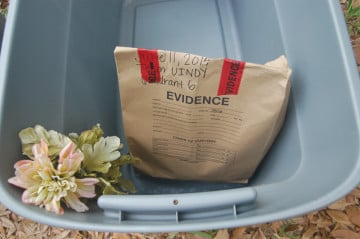
Despite these obstacles, Marta’s luck seemed to be turning. Elmer’s remains had been properly marked with his death certificate number and were among those Baker and her team exhumed from the shallow graves that summer. His DNA was also part of a small batch of migrant DNA information that was published on the NamUs database. By sheer luck, the Argentine Forensic Anthropology Team, a nongovernmental organization that helps solve missing-person cases worldwide, had sent a team to El Salvador just months after Elmer went missing. There they gathered a reference DNA sample from Elmer’s family. In a rare turn, that sample, collected outside the U.S., and not by U.S. law enforcement, was run through the database. A positive match was made. Marta thought it was a miracle. Without the help of volunteers, Marta’s search would never have ended—and there would be no hope for other families in search of their loved ones’ remains in Brooks County. Three years after his death, Elmer Iraheta’s body has yet to be returned to his family in El Salvador. “He is still here,” said Spradley, who said that the lab at Texas State took in some of the unidentified migrant remains exhumed from Sacred Heart, including Elmer’s. “I am waiting for the paperwork from the El Salvador Ministry of Foreign Affairs.” Elmer’s status as “unidentified” must be formally changed to reflect his legal name, and only then can the remains be released. In the year since Lain’s inquiry, Texas legislators have passed only one new law to regulate the handling of migrant remains. It makes the death records of unidentified persons public after a year. This July marks three years since Elmer perished in the desert, and he still hasn’t come home. Yet he may be one of the lucky ones, to be headed home at all. View an autopsy report here.
This article was reported in partnership with The Investigative Fund at The Nation Institute, where John Carlos Frey is a reporting fellow. https://soundcloud.com/texas-standard/texas-observer-reports-mass-graves-investigation-may-have-been-botched